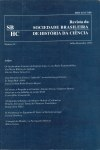Cambridge, o dinamismo e os modelos de Thomson e Maxwell
Abstract
William Thomson (Lord Kelvin)-and James Clerk Maxwell were in the center stage o/ the creative activity leadini to the consolidation of some of the main theories o/ classical physics. Besides theoretical and conceptual innovations, they have left an important epistemological legacy, developing and applying a methodology where the use o/ models and analogies was prominent. ln the present work it is shown how such methods answered to the specific needs ofthe physics ofthat time. Special emphasis is given to the links between this methodology and the "dynamicist "tradition then in development in Cambridge, in substitution to the previous prevalent "mechanistic" vision. Particularly evidenced are the connections between the new Cambridge methods and philosophical and scientific currents externai to the development of physics itself.


